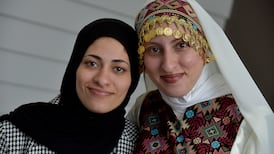Sorcha Kearns was six when her mother, Natasha, first noticed that she was having difficulties in school.
“In senior infants and first class, we were spending an hour to an hour and a half doing homework every evening, and she didn’t seem to be able to retain any information,” says Natasha.
She raised her concerns with the school and was initially told that they didn’t have any concerns. However, when her daughter was in second class, Natasha approached the school again. This time the teacher agreed but said Sorcha would not qualify for assessment with the school.
“Assessments are impossible to get in schools through Neps [the National Educational Psychological Service] because, again, if you want to get your assessment, you have to have multiple other disabilities or challenges,” says Natasha.
‘Wouldn’t it be great if he got voted in?’ The cardinal from Drimnagh tasked with organising the papal conclave
‘My heart shattered. There’s no hope for us’: Families react to housing department’s decision on Dublin flats regeneration
John FitzGerald: Irish unification would hit South harder than 2008 crash
She decided to seek a private assessment for her daughter. Private assessments cost about €500 and, although schools can provide a contribution towards the fee, the balance can still act as a deterrent.
“You have people who would love to get their kids assessed but they don’t have the money, it’s so prohibitively expensive, ” says Natasha. “We were very lucky to be able to do that for our daughter.”
[ How do I spot if my child has dyslexia?Opens in new window ]
When Natasha received a diagnosis of dyslexia for her daughter, she sought support both in and out of school. “Once she was diagnosed, the teachers got the report and they were very supportive of her,” she says. “She didn’t get any extra stuff, but they were aware. They knew not to put pressure on her to do reading in class.”
The family ended up seeking private help. Sorcha attended paid-for tuition classes twice a week with an educational psychologist outside school. “There were times where she was tired and didn’t want to have to do this extra work, but it paid off,” says Natasha.
They started the classes when Sorcha was in third class and continued until she was in second year.
“It genuinely is a lot of work. We put in hours and hours every day, and at weekends, and as a result, she’s in fifth year now doing all honours subjects. In second class you couldn’t give her a book – it meant nothing but pain and torture,” says Natasha. “Whereas now, her favourite thing to get from people is a book.”
While families such as the Kearnses are forced to seek private help, many more students with dyslexia could be supported in mainstream schools if more teachers received appropriate training.
We’d always present it as teaching them to code. Children with dyslexia need to learn the all the elements of the language, starting with individual sounds, and then how to pull them all together
— Anne Marie Kealy, principal of St Rose’s National School in Tallaght
St Rose’s National School in Tallaght, for example, is one of just four “reading schools” in the country for students with dyslexia – even though the condition affects as many as one in 10 students. The school provides intensive support to students with the condition from third to sixth class for a period of up to two years.
“These are children who have had learning support in their own schools and, for whatever reason, it isn’t working for them, or they have such a level of difficulty that they need something more intensive,” says Anne Marie Kealy, principal of St Rose’s.
The school follows the primary school curriculum, but the smaller classes and tailored literacy lessons have an outcome in mind for the students. “Our schools are set up to close that gap and to give them a focused input for the two years,” says Kealy.
They close this gap by adopting a direct approach to teaching reading. “We’d always present it as teaching them to code,” she says. “Children with dyslexia need to learn the all the elements of the language, starting with individual sounds, and then how to pull them all together.”
Every literacy lesson, she says, starts with a drill activity. “The idea of doing the drill every day is that you’re teaching the sounds to an automatic level and you’re teaching the whole structure of the words, not just the sound,” says Kealy.
The school also weaves opportunities into the day for students to engage with reading in a positive and relaxed way.
“There’s a local Irish Countrywomen’s Association group who come and do paired reading with the children every Wednesday, it’s really good,” says Kealy.
Dyslexia affects about one in 10 students, and the key challenges impact how a student learns in relation to reading and writing.

Many with dyslexia also have other underlying difficulties that might involve speed of processing information, working memory difficulties and other challenges managing confidence and self-esteem.
Improved self-esteem is one of the key changes Kealy notes in students who attend St Rose’s.
“Children would always say that they really liked the fact that everybody here is the same – they don’t have to feel embarrassed about reading out in class,” says Kealy. “I did some research a few years ago on children who had been with us and who had subsequently moved on to secondary school. While their reading had improved, the main benefits were their self-esteem, and their confidence and their belief in themselves.”
However, the reading and writing demands of a primary school classroom can have a negative impact on how students with dyslexia view themselves, says Donald Ewing, head of education and training at the Dyslexia Association of Ireland.
“Often people with dyslexia feel that they’re not clever. We must highlight the fact that it’s a mechanical difficulty with decoding and encoding. It just takes more time and a different way of approaching the teaching.”
With so few reading schools in Ireland, it can be difficult to get a place. These schools have similar enrolment policies, and a formal educational assessment is required. Children must have an average or above average IQ coupled with low literacy levels. St Rose’s currently has 60 applications for next year’s 30 available places.
“If there’s a lot of children at the same level, then we would take the older children. We’ve had to prioritise the older children over the last number of years,” says Kealy.
[ Dyslexia: It’s been ‘a bit of a journey, but a great one, full of surprises’Opens in new window ]
Dr Pauline Cogan, educational psychologist and a former primary schoolteacher, believes the number of reading schools in Ireland should be increased.
“I think they’re absolutely brilliant and it is tragic that there isn’t one in every county,” says Dr Cogan. “There should actually be one in each catchment area because there are three such children in every class.”
The demand for places in reading schools is also preventing the impact early intervention can have on a student’s long-term outcomes.
“For every year of delay past first class in learning to read, there is a loss of 15 per cent of potential. When children are diagnosed with dyslexia, in first or second class 83 per cent of those children will have a normal trajectory in schooling.”
In an effort to support early intervention Dr Cogan worked for many years to create a comprehensive assessment tool, known as Test2r, that helps identify dyslexia in students as young as five or six.
“There’s a short screener to identify the young children who are at risk of dyslexia, and there are 13 short tests beyond that, for children who turn out to be at risk,” she says. A colour-coded electronic feedback feature highlights areas that require support.
If a child who does not have dyslexia has to learn something four times before they have mastered it, the dyslexic child has to do it 16 times
— Dr Pauline Cogan, an educational psychologist
“The teacher then has the best part of three years of a teaching programme for those children.” Dr Cogan would like all students to have access to her early screener. “I gave this as a gift to the State so that all children could have it,” she adds.
Ewing says schools should be able to identify students who might be at risk of dyslexia after 18 months of schooling and that early intervention can prevent the onset of confidence issues.
“By identifying an issue and explaining to a young person why they might be having difficulties, it prevents them from coming up with an explanation which might be completely damaging to their confidence,” says Ewing.
Dr Cogan stresses that it is important that teachers slow things down for these students.
“If a child who does not have dyslexia has to learn something four times before they have mastered it, the dyslexic child has to do it 16 times,” says Dr Cogan. This is based on the “square root” theory of reading developed in the University of Sheffield.
“That’s why in successful teaching of a dyslexic child, there are three rules,” says Cogan. “Slow it down, pare it back, and teach it with love.”


















